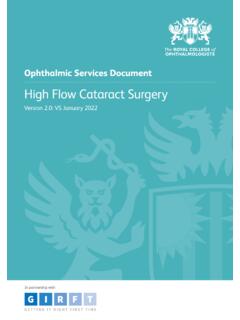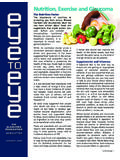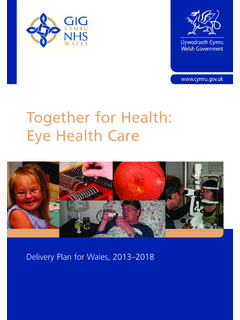Transcription of Ophthalmic Services Guidance Standards for Virtual …
1 Ophthalmic Services Guidance Standards for Virtual Clinics in glaucoma Care in the NHS Hospital Eye Service November 2016 2017/PROF/348 2 Date of review: November 2019 Contents Section page 1 Introduction 3 2. Definition of Standards 3 Section 1: Patients suitable for Virtual clinic monitoring. 3 Section 2: Recommended test procedures and processes within the service. 4 Section 3: Staff involved in service 5 Section 4: Data collection and governance 5 3. Steering group 5 4. Standards Panel 6 5. References: 6 Appendix 1: glaucoma definitions: 7 Appendix 2: Glossary of terms and clarifications 8 2017/PROF/348 3 1 Introduction Chronic eye disease management is a challenge facing the United Kingdom (UK) National Health Service. The UK population is increasing, with annual growth estimates of Predictions estimate that the UK population will have reached approximately 72 million by 2031 (Department of Work & Pensions, 2005).
2 Furthermore, as with most Western countries, the UK is an increasingly ageing population. The increasing prevalence of glaucoma in the elderly population and advances in diagnostic technologies used by primary care providers means that the number of new glaucoma suspect referrals to secondary NHS care are increasing (Edgar et al., 2010, Ratnarajan et al., 2013); however, the chronicity of these conditions means that patients often require lifelong NHS eye service care. As such most hospital eye departments have significant capacity problems with ophthalmology out-patient Services (Chalk and Smith, 2013, Smith, 2013). Most recognise that there is a need to redesign the relevant patient pathways to improve current capacity, reduce overdue review intervals and enhance patient experience of ophthalmology Services . One solution is to adopt a Virtual clinic for managing stable patients. A Virtual clinic is one in which the face-to-face clinician consultation is removed.
3 In a synchronous model, the patient and clinician interact in real time, for example, via a webcam. In the asynchronous model, the interaction occurs at different times. In a glaucoma asynchronous Virtual clinic , technicians gather quantifiable data for clinicians to make value decisions. In this type of model, clinicians can review considerably more patient data than in traditional clinics. With little or no increased capital and recurrent costs, there is emerging evidence of the increasing popularity of Virtual clinics within secondary care both for glaucoma and increasingly medical retina specialties to help deal with increased patient numbers (Court & Austin, 2015, Kotecha et al., 2015, Wright & Diamond, 2015, Clarke et al, 2016, Tsaousis et al. 2016). Technician-led Virtual clinics may be placed at locations independent of the reviewing clinician so enhancing a Trust s ability to deliver CCG ideals of community based care.
4 There are no clear guidelines for the development of these Services . This document aims to define the minimum Standards for the development and implementation of Virtual clinics for glaucoma management in the secondary care settin In seeking to commission high quality cataract surgery Services , it is recommended that commissioners work in partnership with a range of stakeholders, including the Hospital Eye Service, community optometry Services , general practice, social care, adjacent clinical commissioning groups, health and wellbeing boards, service users and carers. Standards were developed by an expert panel and refined following a two-round survey of members of the United Kingdom and Eire glaucoma Society. 2. Definition of Standards Section 1: Patients suitable for Virtual clinic monitoring. 2017/PROF/348 4 Patients suitable for the service will be those deemed suitable for the service at the discretion of their referring consultant, and may include those with: i.
5 Ocular hypertension (OHT); ii. Suspected open angle glaucoma ; iii. Early or moderate * primary open angle glaucoma in the worse eye; iv. Bilateral pseudophakia and a primary diagnosis of early or moderate * primary angle closure glaucoma in the worse eye; * where early and moderate disease stage are based on the criteria developed by Damji et al. (See Appendix). Patients not suitable for this service would include those in whom it is anticipated that the quality of data collected will be of insufficient reliability for the delegated glaucoma reviewer to make a safe clinical decision ( unable to perform visual fields, poor disc imaging). Diabetic patients moved to a Virtual clinic should be reminded to continue to attend their local Diabetic Retinal Screening Service for annual retinal screening. This should also be recorded in any GP correspondence. Patients with co-existing ocular comorbidities ( uveitis, age-related macular degeneration) who require monitoring of their condition will not be suitable for this service.
6 Section 2: Recommended test procedures and processes within the service. It is recommended that patients attending the Virtual service have the following tests performed: i. Visual acuity testing at each visit; ii. Thresholded automated visual fields at intervals clearly specified by the referring consultant/ delegated glaucoma reviewer; iii. Intraocular pressure (IOP) measurement using a validated and appropriately calibrated tonometer at each visit; iv. Disc imaging using a validated method of imaging the optic disc at intervals clearly specified by the consultant/ delegated glaucoma reviewer; v. Central corneal thickness (CCT) measured at least once, if not previously recorded. vi. A van Herick or equivalent objective ( optical coherence tomography) measurement of the anterior chamber angle depth as specified by the referring consultant/delegated glaucoma reviewer; * vii. A recording of the patient s compliance to treatment, where appropriate, and any difficulties arising since the last visit.
7 * Gonioscopy in the outpatient clinic is recommended if there is a change in patient status, IOP destabilises or there are signs of progressive disease. 2017/PROF/348 5 Recording of such data may take the form of a tick box questionnaire administered by the technician to highlight potential issues to the delegated glaucoma reviewer for further action. The technicians delivering the service should not be expected to take a full Ophthalmic history. Patients who have been deemed to show no signs of conversion to glaucoma and who are subsequently discharged from the service should be given clear instructions that they should continue with other ophthalmological monitoring, where appropriate. Discharged patients should be advised to continue with annual/biennial routine community sight tests. The decision for a face-to-face consultant review at the time of discharge is optional and remains at the discretion of the referring consultant ophthalmologist/ delegated glaucoma reviewer.
8 Section 3: Staff involved in service The Virtual clinic is a hospital-led service and as such the overall guarantor of the service should be a consultant ophthalmologist. Departments running the service should keep an updated delegation log that details the service guarantor, the delegated glaucoma reviewer, and the technicians delivering the service, along with the responsibilities of each role. All staff delivering the service should have evidence of training and locally (or, if available, nationally) approved accreditation for their required task, with evidence of regular review to ensure that skills are kept up-to-date. The banding of technician staff working in the service should meet local aspirations that achieve the competencies required to deliver the service. The delegated glaucoma reviewer for this service should be a glaucoma clinician working within the secondary care team to whom the patient s referring consultant is happy to delegate the role.
9 Section 4: Data collection and governance Ideally, all patient information will be collated, controlled and delivered by an electronic patient record (EPR), although lack of an EPR is not a barrier to implementation of this type of service. Departments running such Services will clearly define who is ultimately responsible for patients in the service (in terms of the delegated glaucoma reviewer or referring ophthalmologist). The service should be regularly audited against the Standards . 2017/PROF/348 6 3. Steering group Professor Paul J. Foster, NIHR BRC for Ophthalmology, UCL Institute of Ophthalmology, London Dr. Aachal Kotecha, NIHR BRC for Ophthalmology, UCL Institute of Ophthalmology, London Mr. Simon Longstaff, Sheffield Teaching Hospitals NHS Foundation Trust, Sheffield 4. Standards Panel Steering group members, plus: Professor Augusto Azuara-Blanco, Queens University, Belfast Mr. James F.
10 Kirwan, Portsmouth Hospitals NHS Trust, Portsmouth Professor James E. Morgan, Cardiff University, Cardiff Miss Anne Fiona Spencer, Manchester Royal Eye Hospital, Manchester 5. References: 1. Chalk D & Smith M. 2013. Guidelines on glaucoma and the demand for Services . British Journal of Healthcare Management, 19, 476-481. 2. Clarke, J., Puertas, R., Kotecha, A., Foster, , Barton, K. 2016. Virtual clinics in glaucoma care: face-to-face versus remote decision-making. Br J Ophthalmol [Epub ahead of print]. 3. Court, , Austin, glaucoma clinics: patient acceptance and quality of patient education compared to standard clinics. Clin Ophthalmol, 24,745-9. 4. Department of Work and Pensions. 2005. National Statistics: Focus on older people. [Online] Available: (Accessed January 2014) 2017/PROF/348 7 5. Edgar, D. F., Romanay, T., Lawrenson, J. G. & Myint, J. 2010. Referral Behaviour Among Optometrists: Increase in the Number of Referrals from optometrists Following the Publication of the April 2009 NICE Guidelines for the Diagnosis and Management of COAG and OHT in England and Wales and its Implications.












